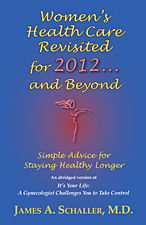 Women's Health Care Revisited
Women's Health Care Revisited Women's Health Care Revisited
Women's Health Care Revisited“Any doctor who can help women understand and resolve their monthly PMS cycle or the chemistry involved in managing menopause ought to win the Nobel Prize. Dr. Jim Schaller should win such an award.”
In this shorter version of his longer work—It’s Your Life!—Dr. James Schaller updates the medical advice provided in his 1997 book for women, which challenged them to take control of their own destiny. After delivering over 10,000 babies and counseling thousands of women over a 35-year career, he challenges many of the current but incorrect protocols that govern the advice of his peers in gynecology.
Now retired, this gynecologist shows how two generations of American women have received sub-optimal medical care, thanks to the power and greed of the pharmaceutical industry and the physicians the companies were able to seduce.
Dr. Schaller provides startling examples of how the for-profit corporations have made hundreds of billions of dollars as purveyors of untested, worthless, dangerous, even deadly chemicals to American medical consumers. He traces the story of the seduction of medical education, medical practice and medical research—since 1960 in gynecology and since 1970 in psychiatry.
In the final third of Women’s Health Care Revisited, the author draws upon over four decades of experience in a very active obstetrical and gynecologic practice to provide explicit advice on the management of hormonal problems in women, emphasizing treatments that should be rejected and treatments which should be embraced.
Because your future health might be at stake, Dr. Schaller’s message is that changes are desperately needed in the way women are treated by the medical profession, specifically for ordinary practices to maintain health, the problems of hormone imbalance and/or deficiency, for cancer prevention and osteoporosis prevention, and for the prevention of cardiovascular disease.
Also by James A. Schaller, M.D.:
|
Table of Contents |
Background: Why Me? Why Now?
Part One: Basic Suggestions
Part Two: Managing Menopause
Part Three: Hormone Replacement Cases
Future Prospects for Women’s Health
Appendix
References
About the Author
|
Excerpt |
Agatha: Rx. for a “Bladder Cripple”
Chief complaint: bladder and vaginal “problems.”
New patient. Age: 74. Periods started “late.” (“Sometime” in high school.) Never pregnant. Married at age 45. Last period: age 48. Never had flushes or flashes or night sweats. Stopped sexual relations age of 69. (Too painful.) Family doctor has treated her for at least ten “urinary tract infections” in last three years. Never had pelvic exam. Urinates at least twenty times a day; but, “was never able to hold much urine.” Since “as long as she can remember,” has had bouts of urgency. Sees red staining on her underwear, occasionally, in past year.
Pelvic exam: All the atrophic signs of long-standing estrogen lack. (External genitalia thin and shrunken, vaginal opening small, vaginal walls inflamed or red, and a urethral caruncle present at the bladder opening. This is a benign lesion, but one which usually bleeds very easily. It is diagnostic of total estrogen lack.)
Discussion: Millions of women spend the last decades of their life as bladder cripples, with frequency, nocturia (going often at night), dysuria (burning and discomfort), and supposed urinary-tract infections (which are often nothing more than inflammation of the very thin, shrunken, non-distensible bladder wall). Most gynecologists realize this condition can safely be entirely prevented, but many fear a lawsuit should the patient get any kind of cancer while using an estrogen-containing ring in the vagina, even though its only demonstrable effect is to prevent or correct atrophy of the vagina and bladder. The simple intra-vaginal estrogen-impregnated ring is used in lieu of any other oral hormones throughout their 50s and 60s and beyond. The anti-estrogen hysteria almost guarantees no family practitioner would dare prescribe it (G.P.s do not have the time or facilities to do pap tests or pelvic exams).
Agatha would not be able to insert or remove this ring, as required every three months (mainly because the opening is now too small and fragile), so an estrogenic hormone cream would be the treatment of choice, in a dose so low, there would be no systemic effects, only repair and normalization of the vaginal and bladder walls. This is another area where progesterone would be indicated, if doctors knew about its wonders or even its availability. The progesterone would not have to be taken orally. Progesterone cream, in a small dose, but one sufficient to block any theoretical chance of estrogen doing harm to the uterine lining, could be added to the estrogen cream.
Blue Dolphin Publishing, 2012